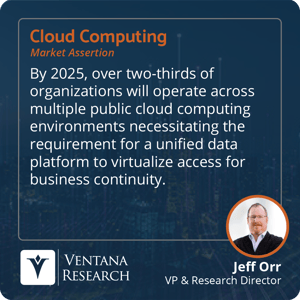Cloud computing has emerged as the catalyst for a shift from digital transformation to digital modernization. This technology offers many advantages, including heightened agility, cost reduction, improved collaboration, enhanced security and accelerated innovation. Hybrid and multi-cloud strategies offer distinctive strengths that enable organizations to optimize the IT infrastructure necessary for digital transformation and modernization efforts.
The urgent demand for digital modernization is propelling organizations to adopt hybrid and multi-cloud strategies. This transition empowers organizations to embrace a cloud computing architecture that combines the advantages of both public and private cloud environments. We assert that by 2025, over two-thirds of organizations will operate across multiple public cloud computing environments, necessitating a unified data platform to virtualize access for business continuity. By utilizing the inherent flexibility, scalability and cost-efficiency of a hybrid approach, organizations enhance the likelihood of successful digital modernization initiatives and navigate the digital business objectives set forth by the chief information officer.
computing architecture that combines the advantages of both public and private cloud environments. We assert that by 2025, over two-thirds of organizations will operate across multiple public cloud computing environments, necessitating a unified data platform to virtualize access for business continuity. By utilizing the inherent flexibility, scalability and cost-efficiency of a hybrid approach, organizations enhance the likelihood of successful digital modernization initiatives and navigate the digital business objectives set forth by the chief information officer.
Maximizing the unique capabilities of different cloud providers is essential for optimizing workloads. Public clouds provide readily available services, extensive scalability and computing resource elasticity, enabling swift deployment of applications and infrastructure without substantial initial expenses. But private clouds deliver robust digital security, compliance measures and control over sensitive data and critical workloads. By implementing a hybrid approach, organizations can allocate workloads based on specific needs, such as data sensitivity, performance requirements and regulatory compliance. Event-driven architecture and applications facilitate integration across clouds to improve data management and governance. This customized approach maximizes resource allocation, ensuring efficiency and unlocking the full potential of cloud computing.
The adoption of a hybrid computing architecture aligns with broader digital modernization endeavors pursued by organizations. Legacy systems and on-premises infrastructure frequently impede innovation and agility. Embracing a hybrid model enables organizations to transfer applications and workloads to the cloud, reducing reliance on outdated systems and fostering a more agile IT environment. This incremental migration approach empowers organizations to modernize the technology stack, leverage cloud-native capabilities and integrate emerging technologies like artificial intelligence, machine language and the internet of things. By embracing a hybrid computing architecture, organizations embark on a transformative journey towards digital modernization, fueling competitiveness and enabling future growth.
A hybrid and multi-cloud approach provides the flexibility to choose the most suitable cloud provider for each workload or application. Our Analytics and Data Benchmark Research.png?width=300&height=300&name=Ventana_Research_Analytics_and_Data_Cloud_Providers_Used%20(3).png) found that 2 in 5 organizations have more than one cloud service provider. Multiple providers allow organizations to align business objectives based on pricing models, performance requirements, geographic presence or specific service offerings. Avoiding the constraint of being tied to a single vendor and engaging multiple cloud providers means organizations can maximize flexibility, negotiation power and the value derived from cloud services.
found that 2 in 5 organizations have more than one cloud service provider. Multiple providers allow organizations to align business objectives based on pricing models, performance requirements, geographic presence or specific service offerings. Avoiding the constraint of being tied to a single vendor and engaging multiple cloud providers means organizations can maximize flexibility, negotiation power and the value derived from cloud services.
Healthy competition among hyperscale providers incentivizes them to offer more competitive pricing, improved service-level agreements and enhanced support. Organizations are well-positioned to negotiate better terms, pricing and conditions, leading to cost optimization and increased value derived from these services. Using multiple cloud providers enables organizations to tailor cloud strategies to specific needs, enhance operational efficiency and extract the greatest benefits from digital modernization initiatives.
Hybrid computing architecture brings a wealth of benefits to organizations engaged in both digital transformation and digital modernization. By harnessing the strengths of various cloud platforms, organizations unlock greater levels of flexibility, scalability, cost-efficiency and agility. Embracing hybrid and multi-cloud environments empowers organizations to steer clear of vendor lock-in and select the best services from multiple cloud service providers, maximizing negotiation power. This strategic approach plays a critical role in driving digital transformation but also holds significant importance in advancing digital modernization efforts. By adopting hybrid and multi-cloud models, IT leaders can dynamically scale resources, efficiently distribute workloads, optimize performance and effectively implement digital modernization initiatives. The advantages of a hybrid computing architecture can pave the way for future growth and innovation.
Regards,
Jeff Orr

 computing architecture
computing architecture.png?width=300&height=300&name=Ventana_Research_Analytics_and_Data_Cloud_Providers_Used%20(3).png) found that 2 in 5 organizations have more than one cloud service provider. Multiple providers allow organizations to align business objectives based on pricing models, performance requirements, geographic presence or specific service offerings. Avoiding the constraint of being tied to a single vendor and engaging multiple cloud providers means organizations can maximize flexibility, negotiation power and the value derived from cloud services.
found that 2 in 5 organizations have more than one cloud service provider. Multiple providers allow organizations to align business objectives based on pricing models, performance requirements, geographic presence or specific service offerings. Avoiding the constraint of being tied to a single vendor and engaging multiple cloud providers means organizations can maximize flexibility, negotiation power and the value derived from cloud services.








